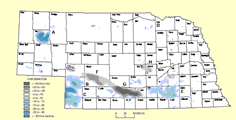Natural Resources, School of
Date of this Version
2018
Citation
Water 2018, 10, 975
Abstract
Impermeable aquifer boundaries affect the flow of groundwater, transport of contaminants, and the drawdown of water levels in response to pumping. Hydraulic methods can detect the presence of such boundaries, but these methods are not suited for mapping complex, 3D geological bodies. Airborne electromagnetic (AEM) methods produce 3D geophysical images of the subsurface at depths relevant to most groundwater investigations. Interpreting a geophysical model requires supporting information, and hydraulic heads offer the most direct means of assessing the hydrostratigraphic function of interpreted geological units. This paper presents three examples of combined hydraulic and AEM analysis of impermeable boundaries in glacial deposits of eastern Nebraska, USA. Impermeable boundaries were detected in a long-term hydrograph from an observation well, a short-duration pumping test, and a water table map. AEM methods, including frequency-domain and time-domain AEM, successfully imaged the impermeable boundaries, providing additional details about the lateral extent of the geological bodies. Hydraulic head analysis can be used to verify the hydrostratigraphic interpretation of AEM, aid in the correlation of boundaries through areas of noisy AEM data, and inform the design of AEM surveys at local to regional scales.
Included in
Geology Commons, Geomorphology Commons, Hydrology Commons, Paleontology Commons, Sedimentology Commons, Soil Science Commons, Stratigraphy Commons


Comments
© 2018 by the author.
Open access
doi:10.3390/w10080975